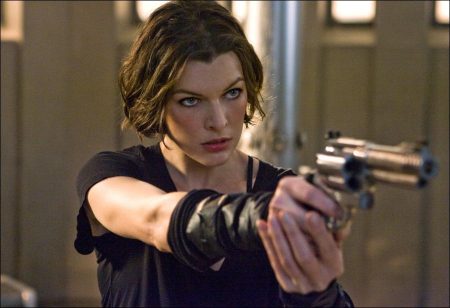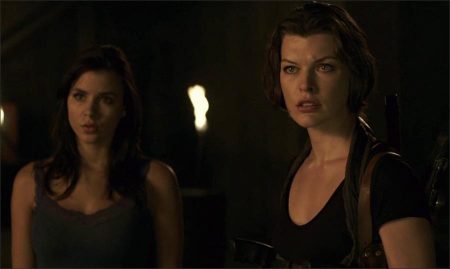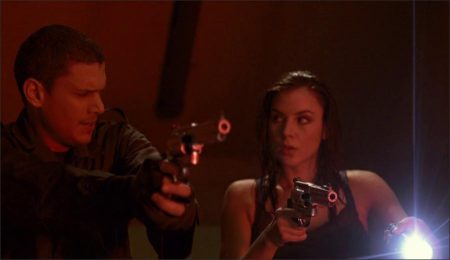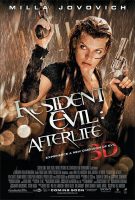Taglines: She’s back…And she’s bringing a few of her friends.
In a world ravaged by a virus infection, turning its victims into the Undead, Alice, continues on her journey to find survivors and lead them to safety. Her deadly battle with the Umbrella Corporation reaches new heights, but Alice gets some unexpected help from an old friend. A new lead that promises a safe haven from the Undead takes them to Los Angeles, but when they arrive the city is overrun by thousands of Undead – and Alice and her comrades are about to step into a deadly trap.
In the first three chapters of the highly successful Resident Evil franchise, Alice, the nearly indestructible zombie fighter played by Milla Jovovich, finds herself in ever more desperate straits as she faces off against the sinister Umbrella Corporation and the murderous army of undead its technology has created. The fourth installment, Resident Evil: Afterlife, takes the series to an entirely new level, with more mindboggling stunts and effects than ever—this time in 3-D. In the words of producer Jeremy Bolt, “The movie has big guns, beautiful women, dogs with heads that explode, awesome landscapes. But most importantly, it has Milla, and Milla is on fire in this movie.”
Franchise creator Paul W. S. Anderson is back at the helm of Resident Evil: Afterlife, after taking a two-film hiatus from directing duties. “I missed directing the films,” says Anderson. “Resident Evil has always been a rich playground for me. I disappeared for a month playing the first two games and emerged from my hatch with a giant growth of beard.”
Anderson has taken a bold approach with the latest film, reinventing the franchise with bigger effects, epic vistas and terrifying new adversaries. “And we shot with the latest in 3-D technology, the cameras used to shoot Avatar,” he says. “It is really exciting to be on the cutting edge of a new technology.”
The director started his career shooting such futuristic thrillers as Mortal Kombat and Event Horizon, films he says he always envisioned in 3-D. “I wanted to immerse the audience in the action the way simulator rides like Back to the Future: The Ride did,” says Anderson. “I feel like a filmmaker who is making the jump from silent pictures to talking pictures. This kind of moment in cinema history, when the technology changes in such a radical way, only comes along every 30 or 40 years.”
One of the most popular movies franchises of all times, the Resident Evil films are based on the blockbuster video games of the same name. Eight years after the premiere of the first film, audience demand remains strong. “From a commercial point of view, it made a lot of sense to make another one,” says Jeremy Bolt, Anderson’s longtime producing partner. “Each of the films has made substantially more money than the previous one. Along the way, the material has evolved in a very interesting way and Paul has matured as a filmmaker. When we began, we thought the movies were all about the special effects and the action. Now, Paul is much more interested in the emotional journey of the characters.”
Resident Evil: Afterlife picks up where the third film, Resident Evil: Extinction, left off. “Alice has managed to escape the clutches of the Umbrella Corporation yet again,” says producer Don Carmody. “She makes her way to Alaska in search of any possible survivors of the plague. The adventure continues as she is reunited with an old friend and they try to find out what happened to their fellow survivors.”
What they discover on their journey is a terrifyingly altered world, overrun by the T-virus. Few humans still survive and the undead have become stronger and much more intelligent. The site of most of the action is a nightmarish simulacrum of present-day Los Angeles. “Paul came up with a great take,” Bolt says. “In the last one, we had post-apocalyptic Las Vegas. This time we were working with the idea of Hollywood in a kind of hot nuclear winter.”
The setting was inspired by the forest fires that raged on the outskirts of Los Angeles as Anderson began work on the screenplay. “Even with all of our modern technology and thousands of firefighters, it still takes weeks and weeks to get these forest fires under control,” he observes. “It started me thinking—what would happen if there were no human beings left to fight these natural occurrences? The fires would sweep down off the hillsides and go straight through L.A., through Beverly Hills, down Sunset Boulevard, past the Hollywood sign and just keep going. That’s the Hollywood we portray in this movie. It’s a burning city, which I thought was very fresh imagery.”
In this unfamiliar setting, Alice must grapple with a new challenge: her own mortality. “Over the series of the first three movies, Alice developed superhuman powers as a result of a mutation caused by the T-Virus,” says Anderson. “When she confronted a few zombies, she could just make them explode. If she got bit, she would regenerate. I felt she’d reached the point where we didn’t feel scared for her any more. If we were going to make another movie, Alice had to lose her powers. We took her back to the place she was in the very first movie: a skilled warrior, but just a human being.”
And just as Alice becomes more vulnerable, the zombies are evolving into ever more dangerous foes. “One of the strengths of the games that we’ve incorporated into the movie franchise is that the undead do evolve,” says Anderson. “They are fresh and more interesting and more exciting each time around, as well as becoming more difficult adversaries. The zombies in this movie are changing faster than humans can evolve.
“You have to wonder if they will eventually out-evolve human beings and become a viable race of their own,” he continues. “With the world semi-decimated, who are the real inheritors of the Earth? Is it the last remnants of humanity or is it the creatures who want to eat the last remnants of humanity? You begin to wonder if the undead are the new world order and the human beings who remain are like the last of the dinosaurs.”
Finding the hidden pockets of survivors has become increasingly difficult for Alice, who is constantly in the crosshairs of the Umbrella Corporation. “We often joke that if you see her coming, the first thing you should do is run,” says Anderson. “Even though she says, ‘I’m going to take care of you,’ chances are, by the end of the last reel, you’re going to be dead. It’s like the television show ‘Murder She Wrote.’ If that character comes to stay at your house for the weekend, you should just run away, because somebody’s going to get murdered.” But beyond the thrills and action, Resident Evil: Afterlife tells a compelling story that continues to resonate with audiences, says the director. “It has always encompassed bigger ideas, like the concept of the evil corporation being the true enemy,” says Anderson. “That is a slightly larger idea than a traditional horror or action-horror movie. Those bigger ideas are why the movies have thrived as long as they have done, and it’s why we’re on a fourth one.
“The human spirit burns very, very brightly in the Resident Evil movies,” he continues. “That’s the beacon of hope and that’s why Alice can continue to live and continue to fight. In the last film, we saw her wandering in the desert, very much a loner. She had become very burned-out and cynical. By the end of that movie, there’s a relationship building between her and another survivor, Claire Redfield, that is continued in this movie. It’s one of the most hopeful things in the franchise.”
Resident Evil: Afterlife packs its share of surprises and continues the tradition of including a twist that audiences aren’t likely to see coming. “Just when the story is wrapped up nicely, when everything has been resolved, The Umbrella Corporation rears its evil head for one more surprise,” says producer Robert Kulzer. “It’s a beautifully mounted movie that is going to knock your socks off with amazing action, beautiful people, flawlessly choreographed fight scenes and knockout visual effects. It’s going to be amazing.”
Continue Reading and View the Theatrical Trailer
Resident Evil: Afterlife (2010)
Directed by: Paul W.S. Anderson
Starring: Milla Jovovich, Ali Larter, Wentworth Miller, Kim Coates, Shawn Roberts, Sergio Peris-Mencheta, Spencer Locke, Boris Kodjoe, Sienna Guillory, Kacey Clarke, Norman Yeung, Christopher Kano
Screenplay by: Paul W.S. Anderson
Production Design by: Arvinder Grewal
Cinematography by: Glen MacPherson
Film Editing by: Niven Howie
Costume Design by: Denise Cronenberg, Azalia Snail
Set Decoration by: Carolyn ‘Cal’ Loucks
Art Direction by: Brandt Gordon
Music by: tomandandy
MPAA Rating: R for sequences of strong violence and language.
Studio: Sony ScreenGems
Release Date: September 10, 2010






